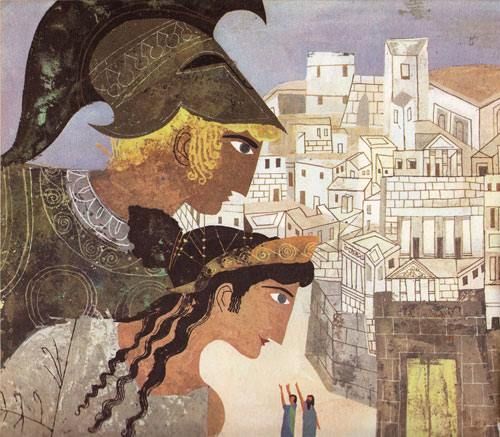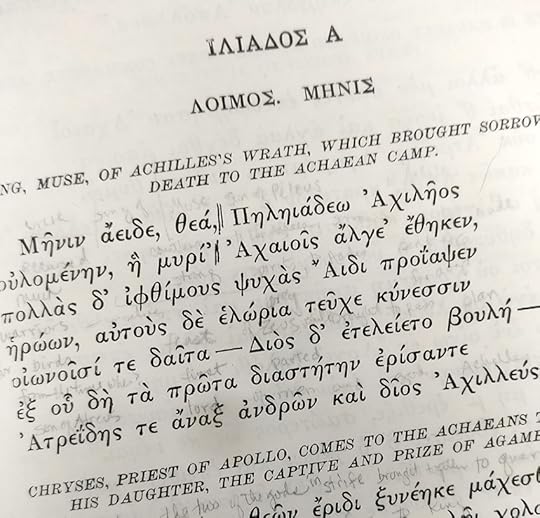Origins of an Obsession
Apollo and Athena look down on Troy. Alice and Martin Provensen, The Iliad and the Odyssey (Golden Books)
When I was 8, my parents went on a trip to Kentucky, leaving me in the care of my maternal grandparents, who lived downstairs. I don't remember the circumstances; it must have had to do with my father's work, but this trip was exceptional. Except for visiting my father's dying brother in Florida, fifty years later, it was the only time my mother ever flew on an airplane. She was asthmatic at a time when that disease was not well-controlled, and travel was difficult and anxiety-provoking for both my parents. But that one time, they went. I remember feeling confused and nervous, but trying to be good about it. And I remember when they came back home, both because I was very glad to see them, and because my mother brought me a special present that she had found in a city bookstore in Louisville.
It was The Golden Book of Myths and Legends, illustrated by Alice and Martin Provensen, and I was instantly captivated. The book also included the tales of Beowulf, the Battle of Roncevaux, Tristram and Iseult, Rustem and Sohrab, and Sigurd of the Volsungs, but the entire first half was devoted to the Greek myths. I pored over the paintings: Prometheus stole fire from heaven; Theseus faced the Minotaur in the Cretan labyrinth; a helmeted Jason fled with the Golden Fleece, Daedalus stood on a rooftop studying the birds. I was already a good reader, but my mother helped me with the text and unfamiliar words, and together we studied the pictures and talked about the stories. She had studied Greek art in college, and showed me how the illustrators had adapted the style of ancient vase paintings to a modern idiom. She pulled out her copy of Bullfinch's Mythology when I wanted to know more. Although she didn't know how to read Greek, she taught me to recite the letters of the alphabet, and how to write the characters, and we talked about the Greek origins of many English words.
That Christmas, my parents gave me the Provensen's illustrated Iliad and Odyssey. My mother read it to me when I was sick in bed, and again we pored over the pictures -- these were even more closely linked to Greek vase paintings. She talked to me about the use of positive and negative space; I traced and copied some of the illustrations. The story and the characters got under my skin and into my head, and stayed there, while the gods and goddesses, in profile, looked down on the warring camps of Greeks and Trojans from the heights of Mt. Olympus, their feuds and jealousies mirroring the behaviors of people I knew. I identified most with grey-eyed Athena, who remained above the love-quarrels by staying a virgin, and encouraged wisdom, intellect, and music as well as being the patron goddess of the Athenians. We read the story countless times, and in spite of my preference for Athena, I always went against her and rooted for the Trojans, knowing it was fated for them to lose, but somehow hoping that my wishes would make the story turn out differently. It was the same when I got to university and enrolled in ancient Greek classes, and, in the second semester, opened my student edition of Homer to the first words of the Iliad. And it's been the same every time since, in every translation: the inevitability of defeat battling with my desire for a different result, as if human fate itself could be held suspended or reversed by the force of my own free will. Much later, I would come to see that the Greeks themselves were concerned with the same questions of fate vs free will, and that it would play a large part in the development of their tradition of tragic drama and exert a profound influence on Christianity, and later western drama and philosophy.
I can't explain the hold that this art and this particular story has had on me, all my life; all I can do is trace it back to its origin. I became a classics major; I almost decided to teach art history or become a conservator of antiquities, but instead became a graphic designer and artist - and I'm convinced to this day that my early study of those vase paintings, and their positive-negative harmony, and the beautiful carved inscriptions of perfectly-balanced Greek letters, had a lot to do with why I became a designer and careful typographer myself, and why my own art has always been concerned with line, and with volume.
Laying Out of a Young Man in the Family Circle, Attic Greek, around 400 BC, white-ground polychrome lechythos (Altes Museum, Berlin)
One day shortly before J. and I left for Greece in mid-November, I began thinking about my mother, and my eyes suddenly filled with tears: how she would have loved to go! Yet in 83 years, she never left the continental U.S. and, like many people in my travel-averse family, hardly ever traveled far from her rural home. But she traveled the world vicariously through me, and through books and the pages of The New Yorker and New York Times, often sending me clippings about some new archaeological discovery. Now, all these years later, I was finally going there, and she was gone from the earth; I wouldn't even be able to tell her what I saw. That particular morning, the prospect seemed unbearable, and I wept. But later, while packing, I decided to wear one of her silver bracelets throughout the trip, and I spontaneously pulled out a favorite black-and-white photograph of her, and stuck it in the back of my sketchbook. When we arrived in Athens, I put the photograph on the table in front of the mirror, and went up to the roof, and saw the Acropolis and the Parthenon for the first time. She was there with me, then, and in my heart, I told her all about it.






